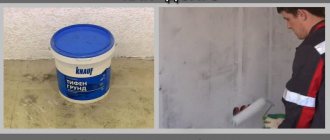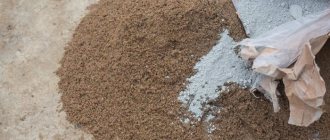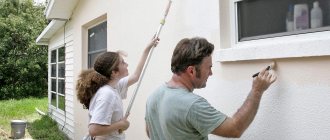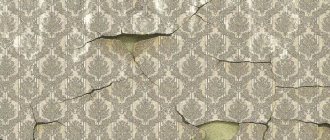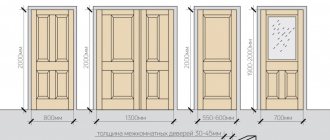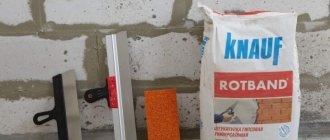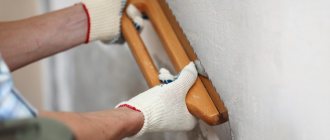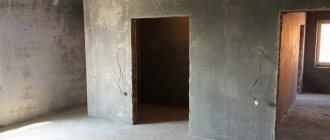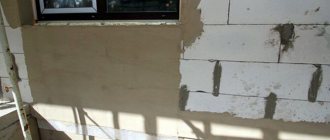Even a beginner can handle applying plaster
Disadvantages of plaster:
- The complexity of the process. Despite its simplicity, plastering work will require considerable physical effort to prepare the solution and apply it. To facilitate the procedure, construction mixers and mechanized laying are used to finish large areas.
To facilitate the application of plaster, mechanized laying is used.
The plaster has to be chipped for electrical wiring
When not to plaster walls?
Situations when you can do without plastering walls:
- When decorating walls with clapboard, siding, plastic, etc. In this case, the rough base must be thick and durable.
- Leveling is carried out with plasterboard boards. The requirements for the rough foundation are the same as in the previous case.
- Smooth entire walls made of monolithic concrete or slabs. Before wallpapering or painting, it is enough to putty them.
- Buildings made of quality limestone. This material does not require additional protection, maintaining its original quality for hundreds of years.
Creating a protective layer
Many modern building materials used for the construction of low-rise private houses have rather poor resistance to moisture. In their manufacture, the main emphasis is on increasing the thermal insulation characteristics by creating internal voids. If such walls are not additionally protected with facade plaster, moisture that penetrates into the voids during freezing will begin to destroy the material from the inside.
We are talking about walls made of:
- Treble brick.
- Foam concrete.
- Aerated concrete.
- Arbolite (based on cement and sawdust).
Is it necessary to plaster the walls in a new building?
Is it possible to avoid such a procedure as plastering walls? The answer to this question depends on what kind of final finishing you want to do. If sheets of plasterboard, plastic or lining are used, which require the initial installation of a frame leveling the surface, then there is no need for plaster.
In situations where you need to tile the walls, cover them with a layer of paint, or stick wallpaper, the plastering process cannot be avoided. In this material, look for answers to questions related to covering the walls in a new apartment with plaster.
Let's first figure out in what cases there is an urgent need to cover different surfaces with plaster.
Combination of different colors and textures
Don't stop at one color. Experiment, and your apartment will sparkle with completely new colors. Concrete goes well with metal, wood and other rough surfaces. If you are a fan of bright colors, then go ahead and use them. But only in reasonable quantities. Dark wood, such as oak, looks best with concrete.
Walls made of concrete, cinder block or brick
Often, walls of this type are found in new, newly built apartments. Plastering walls is necessary to achieve the following goals:
- Leveling the surface of the walls. Thus, you can completely get rid of cracks and unsightly protrusions. But the main thing here is not to forget about the shrinkage that follows the masonry process, which will lead to the fact that in a couple of months the frame of the building will change shape due to pressure under its own weight;
- Closing seams at joints. As a result, you can achieve a complete surface, without which it is impossible to proceed to the finishing coating of the wall with decorative materials;
- Protecting the base from negative environmental factors. A similar problem often occurs in apartments where humidity is high. Thanks to the additional plaster barrier, the house will last much longer, which is undoubtedly good news;
- Giving the room an attractive appearance. One cannot but agree that the appearance of untreated concrete is a little depressing - in such a situation, even ordinary plaster under the “fur coat” coating improves the aesthetic properties of the room. What can we say about Venetian plaster!
The basis of almost any renovation in a new apartment is the preparation of the external surfaces of the partitions for finishing coating with separate layers of tiles, wallpaper or paint. The optimal level of operating properties of the room depends on how well the walls in the new apartment are plastered.
Applying plaster to walls
The process of plastering walls and plasterboard partitions in a new building is simply coating the surfaces with special solutions and then leveling the applied layer. Covering the walls with plaster is considered the most important stage of finishing work. As a result, all vertical surfaces acquire a surprisingly smooth appearance and can fully accept finishing coatings. In this case, all irregularities in the walls (both planar, such as cracks or bumps, and angular) disappear. Deviations associated with incorrect angles of the walls disappear (if the angles are aligned at 90 0). As a result, the ideal geometry of the room is created, without which it is impossible to lay tiles or install built-in kitchen furniture.
Before deciding on the need to apply plaster in a new apartment in a panel house, you should take into account the purpose of using the room, its contents and the style of finishing. In any case, it is important to understand that there is not always a need to level the walls with plaster. Sometimes such an attempt to do better leads to the fact that the repair takes longer than necessary - due to the drying out of individual layers of plaster of great thickness.
Application
Very often, in new buildings, partition materials made from foam blocks, cinder blocks and bricks are used, less often from monolithic panels. If finishing is not provided, then it is necessary in any case; if it is not done, then leveling will affect:
- Removal of surface defects; seams, cracks, depressions and bulges in the wall will be completely covered.
- Leveling the plane so that the wall is perfectly flat and smooth, ready for finishing.
- Protection from external factors, the walls absorb all the moisture, as a result they gradually collapse, their strength characteristics decrease.
- Without finishing, the quality of the wallpaper will be at a low level; all the imperfections of the wall will be transferred to the relief of the canvas.
After leveling, the walls can be covered with any finishing coating. Almost half of all residential buildings consist of monolithic panels, at first glance the plane of the walls is even.
But, as practice shows, to obtain first-class quality repairs, ideal wall alignment is not only necessary, but also necessary for:
- Increasing thermal insulation properties. The seams between the panels in a monolithic house shrink over time and begin to show through. In cold weather, heat loss increases several times.
- Increasing moisture protection and sound insulation, the more layers there are on the wall, the less noise from the street will pass through.
- Reducing the likelihood of fungus and mold appearing on the surface.
- To create a complete, durable layer of the wall surface, which eliminates the possibility of deformations, cracks and breaks.
- Opportunities to cover the wall surface with any decorative design (wallpaper, paint, panels, etc.)
If you decide to level the walls with plaster yourself in panel houses, you must follow the basic rules and procedure for performing the work step by step.
In general, the whole process is labor-intensive and precise, but almost anyone can handle this task. You should also understand that it would be more advisable to remove the previous layer of plaster.
What materials are best for plastering in new buildings?
For interior finishing work, experts advise paying attention to solutions based on binder gypsum. Such mixtures dry quickly, guaranteeing proper strength and low shrinkage, which cannot be achieved when using cement mortars. Plaster allows you to independently regulate the climate in the room during its further use. The natural properties of gypsum make it an excellent absorbent. Interestingly, it can also saturate the room with moisture if it becomes too dry.
Gypsum mortar with special additives allows you to extend the “life” of just prepared, fresh mortar; additives increase its plastic properties. The most important mistake of novice finishing professionals is their careless attitude to recommendations on the required amount of water that is used when mixing solutions. If you exceed the prescribed amount of liquid, internal stresses will appear during the drying stage of the plaster, which will lead to the formation of cracks. Read the instructions carefully and do not add more water than required to dissolve the mixture.
The Rotband plaster mixture from the Knauf concern has become very popular recently. This finishing material has good “adhesion” to the coating, which makes it ideal even for walls that are too smooth.
The average thickness of one layer of gypsum plaster is about 18 mm. In most cases, it is applied immediately in one layer. If you need to apply 2 layers, then the second of them is applied immediately to the wet first. Do not forget that the surface for subsequent application of plaster must be prepared: remove dust, moisture and white deposits (efflorescence). If you need to level a wall with several layers of plaster, do not forget that each new layer should be softer. To increase the ability of the solution to quickly adhere to the base, the surface is usually treated with a concrete contact primer. If the walls are too uneven, you need to think about leveling them using sheets of plasterboard or cement plaster.
Recommendations for beginning craftsmen
Plastering is a multi-stage and rather lengthy process. To avoid mistakes, you need to follow the recommendations.
- Plastering is carried out only at temperatures above +5°C . Otherwise, the composition dries unevenly and cracks.
- When working above +25°C , the surface must be moistened with water more often.
- For finishing aerated concrete or wooden walls, it is better to use gypsum compounds.
- Porous materials - slag concrete, wood - draw moisture from the plaster. Priming is required.
- Expansion joints are formed at the joints with door jambs and window frames . For this purpose, expansion rails are installed.
You can begin further finishing work only after the plaster has completely dried.
Plaster in the bathroom
The widespread use of gypsum-based plaster has raised the question: is it possible to use such plaster in the bathroom? The thing is that gypsum has excellent moisture-absorbing properties, as mentioned above. Therefore, there is a high risk of destruction of some layers of plaster due to their generous moisture supply. In such a situation, we recommend reading the instructions on the packages of mixtures for preparing plaster. Pay special attention to the paragraph that indicates restrictions for using them in finishing work in rooms with high humidity levels - this applies, first of all, to the bathroom and kitchen.
According to European rules for finishing premises, the kitchen and bathroom are not related to rooms with high levels of humidity (unlike saunas, for example). Therefore, the restrictions indicated on the packaging of some solutions may only apply to such spaces as a sauna, but such plaster is allowed to be applied to a bathroom.
In any case, in order to clean up the bathroom or kitchen after plastering, we advise you to pay attention to latex paints; tiling the surfaces is considered a classic option.
Leveling walls in a new building
Having bought an apartment in a new building, many families are faced with the need to level the walls. Construction companies often sell living space without finishing, saving on materials and allowing the buyer to choose the tiles or wallpaper themselves. Unfortunately, even in new houses there can be curvilinear curvatures and other defects and unevenness of the walls. If they are not corrected, finishing work loses its meaning, since most finishing coatings must be applied to a flat surface.
How to level walls in a new building?
Leveling the walls is an essential part of repairs in a new building, especially if we are talking about an economy-class house. The shortcomings made by the builders often make it impossible to do high-quality wallpapering, painting, or laying tiles - on a crooked wall, the finishing coatings highlight all the shortcomings and quickly lose their attractive appearance, starting to swell, crack or crumble. To avoid this, it is necessary to level the walls in a new building, having first selected the appropriate technology.
You can level the walls with your own hands, but this work requires experience and skills from the builder. Inaccuracies made at the rough finishing stage are usually difficult to correct, so if the owner has not previously had experience in renovating an apartment, it is better for him to contact a company that professionally provides such services. They have the necessary equipment and experience, which means they will do the work quickly and efficiently.
Decorative look
A façade finished with plaster looks very aesthetically pleasing. Plastering is not always used to protect or level walls. Recently, a technology for finishing external surfaces called “wet facade” has become increasingly popular. This cladding method involves gluing foam plastic, followed by treatment with a decorative layer of plaster, which acts as a finished facade. The advantage is that the method is inexpensive, and as a result you will get insulated walls and an interesting appearance.
Plaster or drywall?
Leveling the walls can be done in a “dry” or “wet” way. In the first case, the master uses sheets of plasterboard to cover the walls, in the second - plaster and putty solutions. The choice of technology depends on many aspects - the size of the room, the complexity of the work, the number and depth of defects. Each material has its own pros and cons that need to be taken into account when choosing the appropriate method for leveling walls in a new building.
Advantages and disadvantages of drywall
Sheets of plasterboard or gypsum plasterboard are a modern material that allows you to level the walls in a room, regardless of the depth and number of irregularities, or create the original geometry of a room, with columns and arches.
Drywall is cheap and relatively easy to install. After working with gypsum boards, there is not as much construction waste left in the room as after plastering, and under their surface you can place a layer of heat-insulating materials, or hide pipes. In addition, finishing walls with plasterboard is a quick way to level walls, since the builder does not need to wait for the solution to dry.
This material is not without its shortcomings. He:
- It is afraid of moisture, which is why it is not suitable for leveling walls in the bathroom;
- Reduces the cubic volume of the room;
- It has low strength;
- Burns well.
Advantages and disadvantages of plaster
Plaster is a time-tested method of leveling walls in new buildings, allowing you to achieve results without reducing the volume of the room. The plaster is very durable, and if the application technology is followed, it can retain its properties for decades without getting wet or crumbling. A layer of this material strengthens the wall and insulates it, helping to seal small cracks, and thanks to its water resistance, the plaster can be used to treat the walls of bathrooms and other rooms with high humidity. The microclimate in rooms with plastered walls is usually better.
The disadvantages of plaster include:
- Long drying time;
- Demanding builder skills;
- High cost of ready-made mixtures;
- A large amount of dirt and debris remaining after work.
Some of the shortcomings of plaster are leveled out if you use a machine rather than a manual method of application. With the help of a special installation, the work is completed much faster and the solution consumption is reduced.
Where to begin
Ideally, the premises of the apartment are made in exact accordance with the project, which implies the correctness of the geometric shapes and sizes. So, the room, unless otherwise provided by the designer’s imagination, should have the shape of a parallelepiped with even right angles and the same dimensions of opposite walls, as well as the ceiling and floor. Life makes its own adjustments to this ideal picture. Therefore, we start by measuring the sides and diagonals of the walls. If the corresponding dimensions coincide with an accuracy of 1 - 2 cm, we move on to the next stage. Otherwise, we correct the “jambs” of the builders. Depending on the size of the identified deviations, plaster and the use of drywall are applicable. Both methods allow you to align walls with wallpaper. The choice of specifics depends on circumstances, including:
- the magnitude of geometric deviations;
- availability of necessary skills among performers;
- time allotted for repairs;
- customer preferences.
Technology for leveling walls in a new building with plaster
Leveling the walls with plaster occurs in several stages. This:
- Wall preparation;
- Installation of beacons;
- Plastering;
- Finishing processing.
Each stage requires more detailed consideration.
Preparing the walls
High-quality leveling of walls in a new building requires certain preparation. If there is already some kind of coating on the surface of the wall, it needs to be removed, otherwise the new layer of plaster will not stick and will soon fall off. In addition, before plastering, the wall is treated with a primer, the choice of which is made depending on the material of which the surface is composed. Thus, concrete walls are treated with a special compound “concrete contact”. You can also apply notches to such a surface, providing better adhesion of the plaster to the wall.
Fastening the reinforcing mesh is another stage of preparation for plastering. They come in metal and fiberglass - the choice depends on what solution is used and what surface it is applied to. Thus, gypsum plaster can be applied to a metal mesh, and lime plaster can be applied to fiberglass, since metal rusts from contact with lime.
Installation of beacons
Perforated metal profiles vertically mounted on walls are usually used as beacons. They serve as guides along which the plaster solution is distributed along the wall, so it is important to position such beacons correctly and accurately in order to effectively level the wall.
The installation of beacons is carried out after the level of wall deviations has been determined. To do this, two holes are drilled in it along a vertical line, ten centimeters from the corner. The first of them is located near the floor, the second - near the ceiling. Dowels are driven into these holes, and self-tapping screws are screwed in, along which the cord is pulled. It must be absolutely straight - this is checked using a level and corrected by screwing in screws. Then the operation is repeated at the adjacent corner, and the entire wall is divided by vertical lines into equal sections. Beacons are installed along these lines - on fastenings or gypsum mortar.
Plastering
Plastering walls in a new building is carried out either manually, using a spatula, or with a plastering machine. The second method is faster and more economical in completing the work, so it is preferable in a situation where it is necessary to level all the walls in the apartment. Professional plasterers usually apply several layers of plaster, flush with the edges of the beacons, and then smooth it with a rule, removing excess mortar. In this case, the beacons serve as guides for the rule, therefore, when installing them, the distance between the individual profiles should be related to the dimensions of the tool.
Finishing
After applying the main layer of plaster, it is rubbed down, leveled with a trowel, and beacons are removed - they can cause rust spots to appear on the coating. The defects remaining after the beacons are also sealed with plaster. In order to make a plastered wall as smooth as possible, it is often covered with putty, but when covering a wall with gypsum plaster using the machine method, you can do without such treatment and immediately begin applying the topcoat.
Selection of plaster mixture
The choice of plaster mixture depends on what material the wall is made of, whether it is located indoors or outdoors, as well as on temperature, humidity and the planned type of finishing coating.
For plastering, cement or cement-sand mortar is often used - it is durable, can be used in any conditions, is impervious to moisture, and is suitable for any surface. You can prepare such a solution yourself from sand and cement, or buy a ready-made dry mixture and dilute it with water according to the instructions.
For internal leveling of walls, gypsum plaster is often used - due to its high plasticity, cracks do not appear on it, and the high drying speed speeds up the work. Due to its smooth surface, a layer of gypsum plaster does not need to be treated with putty, especially if it was applied by machine. At the same time, the composition with gypsum is afraid of water, and is not suitable for leveling walls in the bathroom. Gypsum mixtures are more expensive than cement mixtures, and the surface under them must be covered with a reinforcing mesh.
Lime plaster has antifungal properties and protects the wall from mold, is plastic and durable, but has low strength, takes a long time to dry, and is afraid of moisture. It definitely needs to be puttied.
Mixing the solution
It is convenient to mix the plaster with a construction mixer.
Prepare the solution according to the instructions. To do this, pour water in the specified volume into the dry mixture and stir. It is better to add water several times. On average, 5 kg of plaster requires 1 liter of water. The composition for spraying and covering is made more liquid.
If a ready-made cement-lime mixture is used, the preparation technology is the same. The factory product is in hydrated form. If the mixture is made independently, the lime mortar is prepared in a 1:1 ratio separately and kept in a container until thickened for several days. The component is then added to the cement mortar.
Only slaked lime is added to the plaster mass.
Leveling walls with plasterboard
The use of plasterboard sheets for leveling walls also has its own characteristics. This material is used if there are serious defects and irregularities on the walls. If the curvature of the surface is from 7 to 20 mm, a frameless method of leveling with plasterboard is used - the sheets are glued to a previously prepared wall. The preparation process differs little from preparing a surface for plaster - if there are rough or finishing coatings, they are removed, the wall is primed, after which gypsum board sheets are glued to it.
If the wall curvature is more than 20 mm, frame technology is used. A metal frame is mounted on the wall, to which sheets of plasterboard are attached with self-tapping screws. The process of installing profiles for securing sheets is similar to the process of installing beacons for plaster. This method greatly reduces the cubic volume of the room.
After installation, the drywall is covered with putty, especially at the joints, seams, and screw heads. After this, you can paste wallpaper onto its surface.
Cost of leveling walls in a new building
The cost of leveling walls depends on many factors - the method by which the work will be performed, its volume, the material that the team will use, the level of curvature of the surfaces, and the order of additional services. At the same time, too low prices should alert the client - perhaps the performers do not have a sufficient level of qualifications, or use materials of inadequate quality.
You can see the prices for wall leveling in our company in the table below, or in the price list posted on our website. All amounts are indicated in rubles and are not a public offer. By calling us or leaving a request on the website, you can order a free visit of the appraiser to the site. Our specialist will assess the amount of work on site and calculate the cost of leveling the walls.

